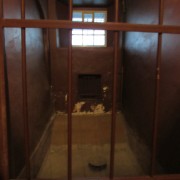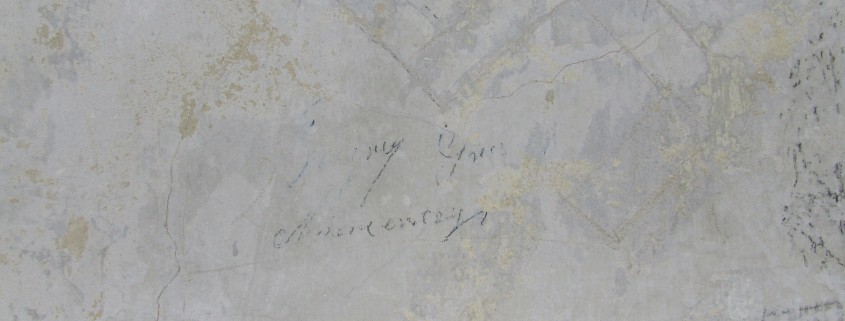The Axis of Fear In Historical Tragedy
By: Jacob Steckel
It is a strange phenomenon that, when facing the past, even those who did not experience events can be marked by them. Especially in the twentieth century, we who study human history and its consequences encounter ferocity, the likes of which are found neither in nature nor in reason. When Edward Gibbon wrote that history is “little more than the register of the crimes, follies and misfortunes of mankind,” he no doubt felt similarly as he gazed upon the ruins of the Roman Empire, touched by the tragedies contained within. In the course of our travels from Vilnius to Warsaw, this group has dealt with cruelty and suffering on a larger scale and with even greater, deadlier efficiency; the question many must ask when faced with these events is simply, “why?”
 It is easy to say that such brutality exists in a vacuum. After all, how could thinking, feeling human beings commit crimes like the Holocaust or Stalinist purges? How could murder become an industry, a science, in a society borne of principles? Surely there can be no rationalization good enough, no explanation to do justice to the atrocities of the Nazis and Stalinists; this is, however, a patently misguided reaction to the past. All human events, regardless of moral bankruptcy, have roots in the feelings of real human beings.
It is easy to say that such brutality exists in a vacuum. After all, how could thinking, feeling human beings commit crimes like the Holocaust or Stalinist purges? How could murder become an industry, a science, in a society borne of principles? Surely there can be no rationalization good enough, no explanation to do justice to the atrocities of the Nazis and Stalinists; this is, however, a patently misguided reaction to the past. All human events, regardless of moral bankruptcy, have roots in the feelings of real human beings.
One need only look at the immediate reactions to September 11th, 2001 with the United States to witness how slippery the slope can be. Less than a month after the attack, the U.S. Congress passed the Authorization of Use of Military Force, a wide-reaching referendum which granted the executive office authority to prevent terrorist acts by “whatever means it deems necessary.” The subsequent invasion of another country and its dubious justification aside, widespread discrimination, abuse and scapegoating took root and persist to this day. Anyone speaking out against the flow of events was looked upon with suspicion by those who supported the tide, and standing by the persona non grata could result in shunning from the community or even hate crimes. Outrage still arises at the mention of a “Ground-Zero mosque” or “Islamification” despite the fact that these labels are misleading and come with a patently hostile agenda.
When the Reichstag caught fire in 1933, a decree was passed which suspended civil liberties in exchange for the perceived protection of the public against “Marxists.” Those who opposed the Nazis’ interpretation of events were ostracized, imprisoned or worse. While the comparison is not perfect, the similarities are numerous; the former example is also recent enough for any American with memories of the last thirteen years to understand what fear in the face of adversity can do to a society. Yet very few from ‘mainstream’ American society have spoken out about the injustice of the situation back home. The explanation is simple: fear.
 In a conversation while on this trip, a student asked whether the Islamic State movement was “actually going to start attacking America.” Comparisons to al-Qaeda and Islamic fundamentalism in the U.S., not in the region experiencing terrors at the hands of the movement, proceeded to dominate the discussion. Even now, the scars of a decade-past event are driving contemporary society to pigeonhole groups as extreme or inherently threatening. While the results are nowhere near as extreme with the example of post-9/11, the fundament which helped begin the Nazis’ gradual conquest of the German legal system is the same: a series of human emotions.
In a conversation while on this trip, a student asked whether the Islamic State movement was “actually going to start attacking America.” Comparisons to al-Qaeda and Islamic fundamentalism in the U.S., not in the region experiencing terrors at the hands of the movement, proceeded to dominate the discussion. Even now, the scars of a decade-past event are driving contemporary society to pigeonhole groups as extreme or inherently threatening. While the results are nowhere near as extreme with the example of post-9/11, the fundament which helped begin the Nazis’ gradual conquest of the German legal system is the same: a series of human emotions.
Fear is not an easy thing to work through. Time and time again, it has driven otherwise compassionate people to heinous acts. The Nazis did not choose to label themselves the Axis without reason; the notion of an ideology which would become, to them, the epicenter of a gravitational well provided stability, a notion of power to those who felt that they were in danger of losing their identities and voices. In Mussolini’s Italy the fasces, the ultimate symbol of ‘united we stand,’ which even now decorates the Oval Office the same as it does the castle at Lublin, was the binding comfort of society as a corporate totality in the face of national insecurity and strife. To the Bolsheviks, the constant perceived threat of capitalist exploitation and imperialism in Marxist-Leninist doctrine was a catalyst to the plans for conquest and purging of “bourgeois order.” None of these movements, regardless of their actions, acted without motivations rooted in recognizable emotions; and with said actions removed from the equation, they might even be somewhat sympathetic.
But actions cannot be removed from the recounting of their role in the not-so-distant past. In no way can they be excused or washed away by simple apologies. Indeed, they are precisely why it is so important to recognize that communal emotions and reactions have consequences. We seek answers to our grief and reprieves from our blackest despairs, and in so doing can forget that in such desperation the people we deem responsible become less human; in making this judgment we lose more of our humanity as well.
At the Tuskulenai Monument, we encountered a hall of dead bodies, each without a name. As I circled around the edge of the boxes, each containing the remains of what was once a human being, I contemplated the manner of their passing. Almost instinctively, my feet stopped and I looked up to find the number “92” in front of me. While this quantification was not done to debase the dead, it was an all-too-clear reminder of the dehumanization of people and the way these ideologies handled those they demonized. It was not emotional detachment which began the KGB tortures in Vilnius, the hundreds of thousands slaughtered at Ponary, the butchery of Poles at the hands of Ukrainians or, yes, the Holocaust itself.
Fear is the soil from which catastrophe is borne. And as I contemplate the meaning of the lives wasted and all the suffering caused by this fear, I come back to that box, nestled beneath its hill on the edge of Vilnius. I wonder sometimes, whether the man in that box had been afraid; I wonder whether, had the tide turned in his lifetime, he would have done the same to those who killed him. In the end, the uncertainty looming above that question is the greatest tragedy I have faced thus far. But in the end, regardless of the systems that put him there or what might have been, I am haunted by “92.”





